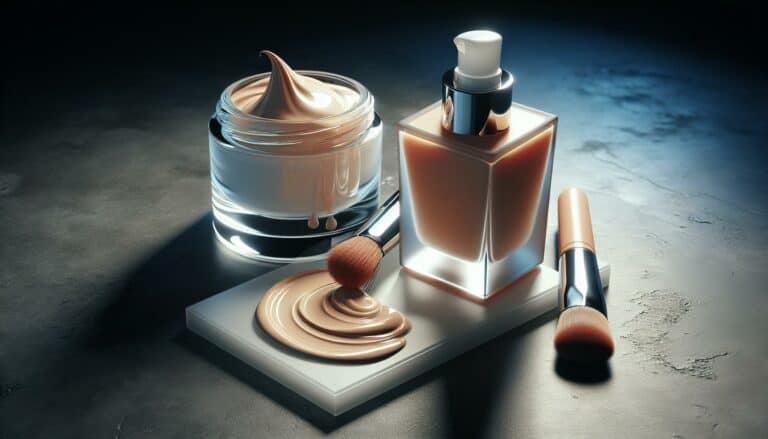How to Make White Foundation: A Complete DIY Guide
Why Make Your Own White Foundation?
When diving into the world of makeup, you’ll quickly find that customization is key to getting that perfect look. Making your own white foundation offers a level of personalization that store-bought options can’t match. Here’s why you should consider taking the DIY route for your makeup needs.
Firstly, let’s talk about ingredients. Commercial foundations often contain a list of ingredients that might as well be in another language. By making your own, you get to control what goes onto your skin, reducing the risk of allergic reactions or breakouts from harsh chemicals.
“Creating your own makeup means what you use is always your choice, empowering you to pick the safest ingredients.”
Furthermore, tweaking the consistency and coverage of your foundation is much easier when you’re the one making it. Whether you prefer something more sheer or full coverage, you can adjust the ratios of ingredients to achieve the desired effect without compromising on the finish or feel.
Let’s not forget about cost savings. Purchasing high-quality makeup can quickly drain your wallet. The table below outlines a basic comparison of costs between homemade and store-bought white foundation options:
| Item | DIY White Foundation Cost | Store-Bought White Foundation Cost |
|---|---|---|
| Ingredients/Materials | $15-20 | $30-50 |
| Customization | Free | Not Applicable |
| Total | $15-20 | $30-50 |
Eco-friendliness is yet another benefit. By choosing to make your makeup, you’re opting for a more sustainable route, cutting down on packaging waste and the environmental footprint associated with commercial production processes.
Understanding Your Skin Tone

Before diving into the process of making your white foundation, it’s crucial to understand your skin tone. Knowing this will guide you in customizing your foundation’s shade perfectly to your complexion. Skin tones can broadly be divided into three categories: light, medium, and dark. However, it’s the undertones that play a significant role in foundation customization. Your skin’s undertone can be cool, warm, or neutral.
A simple way to determine your undertone is the vein test. Check the veins on your wrist; if they appear blue, you likely have cool undertones. Green veins suggest warm undertones, while blue-green indicates a neutral undertone.
| Undertone | Vein Color | Best Foundation Shade |
|---|---|---|
| Cool | Blue | Rosy, Silver-based |
| Warm | Green | Peachy, Golden-based |
| Neutral | Blue-Green | Neutral Shades |
Pro Tip: “Mixing a precise amount of white foundation with tinted ones helps achieve the perfect match, thus highlighting your skin’s natural beauty without overdoing it.”
Remember, the goal is to enhance, not mask your natural skin tone. When experimenting with making your white foundation, you’ll have the flexibility to adjust shades and undertones with ease. By recognizing the significance of your skin’s undertone, you’ll not only craft a foundation that complements your complexion but also one that feels like a second skin, blending seamlessly for a flawless finish.
Choosing the Right Ingredients
When embarking on making your white foundation, it’s pivotal to select the right ingredients. Your foundation’s performance – its coverage, longevity, and feel on the skin – largely depends on what goes into it.
First up, consider the base. There are primarily two types of bases you can choose from:
- Oil-based: Gives a richer texture, suitable for dry skin
- Water-based: Lighter and suitable for oily or combination skin types
Titanium dioxide is your go-to for the white pigment. It’s a natural mineral that offers excellent coverage and has the added benefit of being a natural sunblock.
Here’s a basic rundown of other ingredients you might include:
| Ingredient | Purpose | Skin Benefit |
|---|---|---|
| Zinc Oxide | Sun protection, soothing | Heals skin irritation |
| Sericite Mica | Provides a smooth application | Minimizes appearance of pores |
| Jojoba Oil | Base for oil-based foundations | Moisturizes skin |
Bear in mind, less is often more. Start with small quantities of each ingredient and adjust according to your needs.
“Your skin is unique. Customize your foundation ingredients to match!”
Remember, safety first. Ensure all ingredients are cosmetic grade and suitable for application on the skin. Patch test each ingredient to rule out any sensitivities you might have.
Mixing these components properly can give you a foundation that not only matches your skin tone perfectly but also complements your skin’s health.
Gathering Your Supplies
Before diving into making your homemade white foundation, it’s crucial to gather all the necessary supplies. This step ensures a smooth and hassle-free preparation process.
First off, you’ll need to choose the base for your foundation. This can be either oil-based or water-based, depending on your skin type and the finish you’re aiming for. If you’re unsure about what’s best for you, here’s a quick guide:
| Skin Type | Recommended Base |
|---|---|
| Oily | Water-Based |
| Dry | Oil-Based |
| Combination | Depends on the dominant condition |
Next on your list should be titanium dioxide, the white pigment that gives foundation its color. It’s essential for achieving the desired opacity and coverage. Additionally, consider incorporating other ingredients such as zinc oxide for sun protection, sericite mica to reduce the greasy feel, and magnesium stearate for its adherence and texture-improving properties.
Remember: It’s all about customization. Feel free to experiment with different ratios and components to tailor the foundation to your needs.
For the actual preparation, you’ll need a few tools: a non-metallic mixing bowl, measuring spoons, and a whisk or spatula for blending. An accurate scale can come in handy for measuring out ingredients, especially the pigments, to ensure consistency in the tone of your foundation.
Lastly, don’t forget to have an airtight container ready to store your finished product. Keeping it properly sealed will extend its shelf life and maintain its quality.
By now, you should have a clear idea of what supplies are needed. Making sure you have everything on hand before starting can make the process much more enjoyable and less time consuming. With all your supplies in order, you’re one step closer to creating your perfect white foundation.
Step-by-Step Guide to Making White Foundation
Now that you’ve got your supplies ready, let’s dive into the heart of creating your own customized white foundation. Follow these steps closely, and you’ll have a product tailored just for you.
First off, decide on the base of your foundation. This choice is crucial as it affects your foundation’s texture and compatibility with your skin. Here’s a quick guide:
| Base Type | Benefits |
|---|---|
| Oil-Based | Moisturizing, Dewy Finish |
| Water-Based | Lightweight, Matte Finish |
Step 1: Measure Your Ingredients. Precision is key, so use digital scales to weigh your ingredients. You’ll need about 10g of your chosen base, and 2-5g of titanium dioxide for the white pigment. Adjust the amount of titanium dioxide depending on the coverage you desire. Remember, more pigment equals fuller coverage.
Step 2: Mix Your Pigments. Before adding them to your base, thoroughly mix your titanium dioxide with any other pigments or powders like zinc oxide or sericite mica in a separate bowl. This ensures an even color distribution.
Step 3: Combine with Your Base. Slowly incorporate your pigment mixture into your base using a sterile spatula or mixer. Make sure there are no lumps and the consistency is smooth.
Step 4: Test and Adjust. Test the foundation on your jawline to see how it matches your skin. It’s okay if it’s not perfect on the first try. You can adjust the color by adding more pigment or base as needed.
Pro Tip: Always test in natural lighting for the most accurate results.
Lastly, transfer your foundation to an airtight container. This will keep it fresh and prevent contamination. Remember, homemade cosmetics have a shorter shelf life, so make just enough for a couple of months.
Customizing Your White Foundation
Once you’ve mastered the basics of making your white foundation, the real fun begins: customization. Tailoring your foundation to meet your specific needs can transform your makeup routine.
Understand Your Skin’s Needs
Start by considering your skin type and concerns. Is your skin oily, dry, or combination? Are you looking for matte or dewy finish? Knowing these will guide your choices in oils and powders.
- Oily Skin: Opt for more zinc oxide. It offers a matte finish and helps control oil.
- Dry Skin: Include oils like jojoba or sweet almond oil for a moisturizing effect.
- Sensitive Skin: Titanium dioxide and zinc oxide are natural sunscreens but add chamomile extract to soothe sensitive skin.
Adjusting Pigmentation
The amount of titanium dioxide will dictate the opacity of your foundation. For sheer coverage, reduce the quantity. For full coverage, increase it within reason.
"Finding the perfect shade is a matter of trial and error. Don't be afraid to experiment until you hit the right formula."
Incorporating Additional Benefits
Consider incorporating ingredients that offer more than just color adjustment:
| Ingredient | Benefit |
|---|---|
| Sericite Mica | Adds a silky feel; diffuses light for a soft-focus effect |
| Silk Powder | Provides a matte finish; helps with oil control |
| Vitamin E | Antioxidant; extends the shelf life of your foundation |
Remember, adding too many powders can make the foundation cakey. Start small and increase gradually, testing the consistency on your jawline after each adjustment.
Tips and Tricks
When you’re on the journey to create your perfect white foundation, a few Tips and Tricks can make all the difference. Whether you’re aiming for a look that’s ethereally pale or you’re adjusting the shade to better match your skin tone, these suggestions will help you craft a product that’s uniquely yours.
- Start Small: With any new batch, begin with a small amount. It’s easier to add more pigment or adjust the components than to start over. Remember, less is more when first mixing your ingredients.
- Mixing Tools Matter: Avoid streaks and ensure an even color by using proper mixing tools. A spatula or a mini whisk can make mixing easier, giving you a smooth, uniform foundation.
"Always measure twice, mix once – precision ensures perfection."
- Pigmentation Adjustments: Finding the right balance of titanium dioxide for that perfect shade of white can be tricky. Here’s a quick guide to help you:
| Start with (in grams) | Adjust by (+/- grams) | Notes |
|---|---|---|
| 1.0 | 0.1 | For lighter adjustments |
| 1.0 | 0.5 | For bolder changes |
Remember, these adjustments depend on the initial volume of your foundation mixture.
- Skin Type Considerations: Choose your base—oil-based or water-based—according to your skin type. Oily skin benefits from water-based formulations, whereas dry skin may prefer oil-based bases for added moisture.
- Longevity Tips: To extend the shelf life of your white foundation, add a pinch of a preservative like Vitamin E. Not only does it prevent oxidation, but it also nurtures the skin.
By incorporating these tips and tricks into your foundation-making process, you’ll be well on your way to creating a product that not only matches your skin tone perfectly but also meets your skin’s specific needs. Remember, experimentation is key; don’t be afraid to adjust and refine your formula until it’s just right.
FAQs about White Foundation
You might’ve got the basics down, but there are always a few questions that pop up while you’re getting hands-on. Here are some common FAQs that might help you smooth out any wrinkles in your DIY white foundation journey.
Can I Use Any Type of Oil for an Oil-Based Foundation?
In theory, yes, but not all oils are created equal. For a smoother, non-greasy finish, opt for lightweight oils like jojoba or almond oil. These oils are closer to your skin’s natural sebum, making them an excellent choice for most skin types.
“Choose oils that mimic your skin’s natural oils for a non-greasy, comfortable finish.”
How Long Will My DIY Foundation Last?
The shelf life can vary, but a general guideline is up to 6 months with the proper storage and if a preservative is used. Here’s a quick table for reference:
| Ingredient | Shelf Life Without Preservative | With Preservative |
|---|---|---|
| Oil-Based | 3-4 months | 6 months |
| Water-Based | 2-3 months | 6 months |
Can I Adjust the Pigmentation After Mixing?
Absolutely! It’s all about trial and error. If the foundation is too light, add a bit more zinc oxide or sericite mica. For more coverage, increase the titanium dioxide. Just remember, always start with less—you can add more, but you can’t take it away.
- Start Small: Making small batches allows for adjustments without wasting ingredients.
- Mix Thoroughly: Use a blender or mixer for an even consistency.
- Patch Test: Always test the foundation on your jawline before a full application.
Having these questions answered, you’re one step closer to perfecting your own white foundation. Remember, the key is to experiment and have fun with the process.
Conclusion
In your journey to perfect your DIY white foundation, you’re likely to have a myriad of questions. Let’s tackle some of the most common ones to ease your process:
What type of oil should I use for an oil-based foundation?
- For dry skin, consider jojoba oil or argan oil. Oily skin benefits from grapeseed oil or squalane.
How long will my DIY foundation last?
- Typically, the shelf life is about 6 months. Store your foundation in a cool, dark place to extend its usability.
- Yes, you can add more titanium dioxide for more coverage or include your skin-toned pigment in small increments to adjust the shade.
Remember, starting small and mixing thoroughly is key. Always conduct a patch test to ensure compatibility with your skin.
“Makeup is not a mask that covers your beauty; it’s a weapon that helps you express who you are from the inside.” – Unattributed








